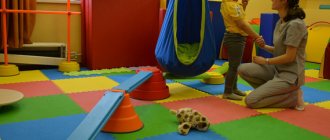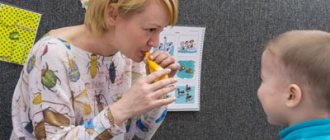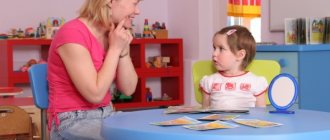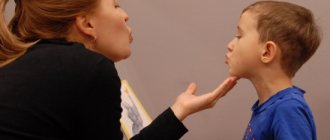Educational and methodological manuals for teachers: the best assistants in achieving professional heights
The diverse assortment of the virtual store will satisfy the needs of preschool teachers and university teachers. The latest developments and methodological literature will allow students to realize their existing potential and help make classes unforgettable and interesting. Those who are gaining experience or have decades of teaching experience behind them will not be disappointed by the range presented.
The thoughtful design of the Uchmag Ru website, clear navigation, clearly structured list - all this saves the visitor’s time, allowing you to quickly navigate the catalog. Information about additional professional education with a calendar of educational events is located on the horizontal panel, and the main sections of the catalog are indicated in the vertical column on the left. The Uchitel Publishing House offers literature for teachers, students, caring parents and those seeking to improve student performance:
- Methodological developments on calendar, lesson planning of the work of subject teachers, organizers of extracurricular activities. Thematic developments using modern technological innovations in the classroom. Printed materials in the required volume, software, disks, flash drives with detailed presentations.
- A variety of products are presented for stands in classroom corners and hallways of educational institutions. Interesting ideas for designing thematic visuals. In addition to ready-made stands, options are offered taking into account the individual characteristics of the establishment.
- For kids, parents, and kindergarten teachers, we offer colorful products that promote the development of children's creative potential. Magazines, books with stickers, coloring books, notebooks for preparing hands for writing, fairy tales, theaters, themed play sets.
- Journal and form products, including reporting sheets, all kinds of magazines (classroom, life and health protection, industrial, sanitary, for health camps).
- Souvenirs, school stationery, literature for self-development.
Journal of speech therapy examination
It is convenient to keep a journal of speech therapy examination in the form given on p. 83. The magazine itself is made from a thick notebook that unfolds horizontally. The speech therapist can also record the examination results in a regular class journal for school teachers.
It is recommended to leave free space in case new children join the group. In such a log, the state of speech in dynamics is clearly visible.
When examining young children, the speech therapist must note the general level of speech development (normal, developmental speech development, dysarthria, features of the anatomical structure of the organs of articulation). When working with middle-aged children, it is necessary to describe in detail the state of sound pronunciation, features of lexical and grammatical development and coherent speech. This will help identify children who need to be transferred to a specialized preschool institution and identify children for enrollment in a speech center. The examination of children of senior preschool age is carried out in a similar way.
The advantage of this journal is that there is no need to annually rewrite the names of all children in the group.
In the notes, the speech therapist makes notes about the child’s transfer to another institution, indicates the date of enrollment or graduation from the speech center, and the number of the protocol in which the fact of enrollment (graduation) is recorded.
Logopunkt GOU d/s No. ________
____________________________
JOURNAL OF SPEECH PEDIC EXAMINATION OF CHILDREN
group no. _________
| No. | Last name, first name of the child | Child's date of birth | 20_ - 20_g Speech development. Recommendations | 20_ - 20_g Speech development. Recommendations | 20_ - 20_g Speech development. Recommendations | Note |
| 1 | ||||||
| 2 | ||||||
| 3 | ||||||
| 4 | ||||||
| 5 | ||||||
| 6 | ||||||
| 7 | ||||||
| 8 | ||||||
| 9 | ||||||
| 10 |
Speech card
For each child enrolled in a speech center, a speech card is created, in which the features of the phonetic side of the child’s speech are recorded (the general sound of speech, the state of phonemic hearing, features of sound pronunciation); state of lexical-grammatical structure and coherent speech.
Speech card of a child who underwent examination[14]
Last name, first name of the child ______________
_________________________________
Date of Birth
________________
Group __________
___________________
General speech sound (normal, pronunciation of sounds is blurred, weakly labilized) _________________________
______________________
Voice (normal, hoarse, nasal) _________________________
Tempo (normal, bradyllalia, tachylalia) ___________________________________
Smoothness (hesitation, stuttering) ___________________________________
Strength (normal, strong, weak, fading) ______________________
Structure of the speech apparatus:
Lips (normal, thick, thin, everted) _______________________
Teeth (edentulous, normal) __________________________________________
Sky (normal, high) ________________________________________
Occlusion (normal, progenia, prognathia, open) ___________________
Tongue (normal, thick, thin, small, massive, geographical, forked) __________________________________________________________
Bridle (normal, shortened, short) __________________________
Salivation (normal, increased) ____________________________
Phonemic hearing (normal, slightly impaired, severely impaired)
__________________________________________________________________
RA-LA-RA ____________ SHA-SHA-SA ___________
SA-ZA-ZA ____________ BA-PA-BA _____________
TA-DA-TA ____________ DE-DE-DE _____________
KA-GA-KA ____________ TE-DE-TE _____________
VE-FE-FE ____________ LE-VE-LE _____________
A hat and a fur coat - that’s the whole bear ____________________________
______________________________________________________________ Osa is barefoot and without a belt ___________________________________________
_____________________________________________________________
The watchmaker narrowed his eye, fixing the watch for us ____________________
_____________________________________________________________
Our Dasha loves drying, drying is not porridge for you __________________
_____________________________________________________________
Lara has a red balloon and a blue scarf ____________________________
_____________________________________________________________
Vowel highlighting:
| at the beginning of a word | at the end of a word | in the middle of a word | ||||||
| Alik | duck | Olya | balls | moon | milk | onion | varnish | juice |
Syllable structure (broken)
______________________________________
Children released birds from cages _________________________________
_____________________________________________________________
Leaves fell off the sea buckthorn branches ___________________________
_____________________________________________________________
There are a lot of perishable foods in the refrigerator ________________
_____________________________________________________________
Policeman Valery regulates traffic _____________
_____________________________________________________________
Policeman __________ Construction ___________
Shipwreck ______ Button _______________
Aquarium _____________ Excavator ______________
Grammatical structure of speech
| Noun units | Noun pl. h. | R. p. pl. h. | R. p. unit | Use prepositions | ||||
| Table | IN | Behind | ||||||
| Window | On | U | ||||||
| Forehead | Under | Above | ||||||
| Ear | TO | From | ||||||
| Chair | Between | Near | ||||||
| Bag | Because of | From under | ||||||
| Bucket | ||||||||
Word formation
| Nouns with a diminutive meaning | Antonyms | ||
| Door | Soft | ||
| Nest | Far | ||
| River | Old | ||
| Iron | Spicy | ||
| Finger | Narrow | ||
| Relative adjectives | Possessives adjectives | ||
| Wooden chair | Fox nose. Whose? | ||
| Glass glass | Dog ear. Whose? | ||
| Leather bag | Bear paw. Whose? | ||
| Brick house | Mom's coat. Whose? | ||
| Paper bag | Dad's boots. Whose? | ||
Connected speech:
Retelling (S, V, N[15]) ____________________________________________
_____________________________________________________________
_____________________________________________________________
_____________________________________________________________
_____________________________________________________________
_____________________________________________________________
A story based on a series of plot paintings (C, V, H) _______________________
_____________________________________________________________
_____________________________________________________________
_____________________________________________________________
_____________________________________________________________
Story based on the picture (C, V, N) _____________________________________
_____________________________________________________________
_____________________________________________________________
_____________________________________________________________
_____________________________________________________________
Formation of the leading hand (lateralities) ________________________
_____________________________________________________________
Pronunciation state
Absence ___________________________________________________
Replacement _______________________________________________________
Distortion (m/z, uvular) _____________________________________
Text for the survey: A fluffy white hare jumped out from under a gooseberry bush. He squinted into the sun and buried himself in a deep hole under a spruce tree.
| WITH | Sue | Z | 3 | C | Sh | AND | H | SCH | L | l | R | Ry | G | TO | X | Y |
Speech diagnosis at the beginning of work
_____________________________________
____________________________________________________________________________________________________________________________________
Final diagnosis
____________________________________________
____________________________________________________________________________________________________________________________________Recommendations
______________________________________________________
____________________________________________________________________________________________________________________________________
"____" ___________ 200____
Speech therapist__
_________________
Why is it profitable to buy methodological literature for preschool educational institutions and educational institutions on the official website of Uchmag Ru?
The products collected on one resource help the work of administration, teachers of specialized and general education institutions, university teachers, psychologists, speech therapists and concerned parents. Time-bound visitors can use the filter to quickly find a suitable guide. It is only necessary to indicate the educational organization for whom the material is intended, the advanced training course, the class or age group of preschoolers, the type of material, product, program, year of publication, and price range. The undeniable advantages of the official website of the Uchmag Ru online store:
- the variety of assortment can satisfy the novice specialist and pedagogical guru;
- user-friendly interface, timely online advice;
- the cost of production is affordable for the average domestic teacher;
- prompt processing of the application and delivery using the buyer’s preferred method.
When to contact a speech therapist: check according to age standards
Dear parents, we offer you a simple and convenient speech therapy calendar that will tell you in what cases and at what age you need to show your baby to a speech therapist.
1 year
You need to contact him if the baby does not hum and babble, he does not utter repeated syllables like “bababa”, “mama”, etc., does not follow a moving toy with his eyes. This is already a reason for a serious examination not only from a speech therapist, but also from neurologist and otolaryngologist.
2 years
If the vocabulary size is 10 words or less, the child does not even speak simple phrases, he is silent, uses gestures, if he has individual sounds, but it seems to you that he “understands everything.”
3 years
At this age, a visit to a speech therapist is mandatory, even if the child is developing within normal limits. Speech therapy help is urgently needed if the baby:
- confuses sounds, replaces one sound with another;
- speaks incomprehensibly, in “his” language;
- is silent, but understands the speech of adults;
- speaks much worse than peers;
- has a poor vocabulary, makes gross mistakes like “red doll”, etc.
UchMag Personal account
To log into your UchMag personal account, go to the official website and register as a personal account.
Login is carried out by phone number or email address. Other booksellers:
Enjoybook
Mynamebook
Ozon Ru
Book24
Read-city
https://shoppingator.ru/uploads/topics/preview/00/00/24/05/eed4d9d996.png
How does an appointment with a pediatric speech therapist work?
An appointment with a speech therapist at a children's clinic involves sitting in queues and is short-term. Doctors do not have time to accurately identify the problem and, accordingly, take effective measures to eliminate it. At the RebenOK clinic, things are different. A pediatric speech therapist in Moscow creates a friendly and cozy atmosphere. By encouraging the patient to play and communicate, which greatly simplifies the process and helps bring the threshold of recovery closer.
An appointment with a pediatric speech therapist includes:
· conducting a survey (conversation with parents);
· examination of the patient, assessment of speech, intelligence, vision and hearing.
The therapeutic block lasts from 30 to 60 minutes and is carried out 1-2 times a week. The first lesson is about assessing language impairment. The speech therapist then decides how many sessions will be needed. According to the directive, 30 sessions are provided for articulation disorders, and up to 60 sessions for speech development disorders.








